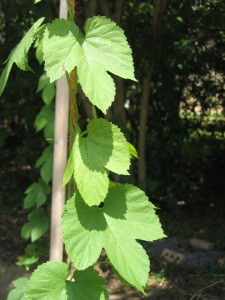Hoppy beers are all the rage these days, and brewers are always looking for ways to get more hop character in their beer. I’d like to discuss maximizing hop aroma, by focusing not only on ways to add hops to beer, but how hop character is removed from beer during the brewing process. I’d also like to propose another method of adding hops to beer. (This isn’t completely new. I’ve mentioned it before, but it isn’t well-known or widely used.)
We all know of a variety of ways to add hops to beer. You can add hops before the boil (first wort hopping). You can add hops during the boil. You can add hops after the boil (in the whirlpool or filter your wort through a hop jack). You can add hops in the fermenter or keg (dry hop). You can push your beer through a Randall. You can even add hops in your mash. But let’s take a look at what happens to the compounds from the hops as the brewing process continues.
Hopping Before, During and After the Boil
Hops added before or in the first half the boil have up to 30% their alpha acids extracted and isomerized into iso-alpha acids (the primary compound that produces hop bitterness). Their volatile oils (from which hop aroma derives) are largely vaporized and lost due to the heat and churning of the wort Some tannins are extracted from these hops, but of these, some react in the kettle with proteins and drop out.
Hops added late in the boil have less alpha acids and tannins extracted from them, and the reactions these compounds undergo is likewise lessened. However, as the oils are boiled for a shorter time, less of them is vaporized and more hop aroma remains. These ideas are why most beer recipes call for some hops (the bittering hops) to be added early in the boil and others (the aroma hops) to be added late. Bittering hops are boiled primarily to yield bitterness. Aroma hops are boiled primarily to add aroma.
Hops added to hot wort after the boil — as in whirlpool hopping or filtering the hot wort through a hop jack — are likewise designed to infuse the wort with hop oils. The lowered amount of heat (and the fact that hop jacks are generally not open) mean more hop oils end up in the wort as opposed to being vaporized into the atmosphere.
Losses During Fermentation
Fermentation reduces the hop character in the wort. Yeast adsorb — or maybe absorb; I don’t think it’s known — bittering compounds. If you would take yeast from a hoppy batch of beer and taste it (or use it bake bread), you would sense that it is very bitter. In addition, the churning, bubbling action of the wort drives off some of the hop aromatics. If you’re an airlock sniffer, you certainly know that the aroma from the airlock can be loaded with hop aroma. So, some of the hop character you add to your beer is removed during fermentation. For this reason, brewers of hoppy beers are urged not to overpitch their IPAs and double IPAs. Likewise running the fermentation at a slightly cooler temperature should result in less blow off of hop aroma. Don’t, however, try underpitching and fermenting below the recommended temperature range of the yeast — this is the recipe for a stuck fermentation.
Even with these losses, brewing a bitter, hoppy beer is possible by simply adding enough hops to compensate for them. And every successful IPA recipe and double IPA recipe does that (knowingly or unknowingly). Of course, we all know of one other way to add hop aroma to beer — dry hopping. In the concluding half of this article, I’ll discuss dry hopping and also propose another method to boost your hop aroma — homemade hop extract. Both of these methods are similar in that they add hop oils to your beer after the boil and after fermentation. Thus, a lower percentage of the oils are lost in the brewing process.
Two ways to add hops, but minimize the loss of oils, are to dry hop or add a homemade hop aroma extract. I will discuss those techniques in the final two parts of this article.
—
Related articles




Speak Your Mind